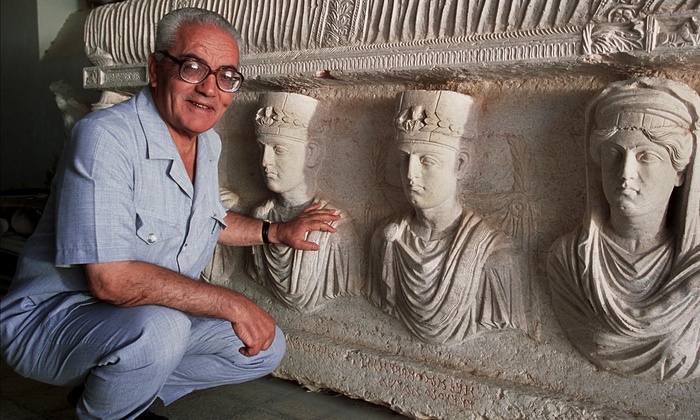Kareem Shaheen in
A 2002 picture of Khaled Asaad
in front of a rare sarcophagus from Palmyra depicting two priests dating from
the 1st century. Photograph: Marc DEVILLE
Islamic State militants
beheaded a renowned antiquities scholar in the ancient Syrian city of
The brutal murder of Khaled al-Asaad,
82, is the latest atrocity perpetrated by the extremist jihadi
group, which has captured a third of both Syria and neighbouring
A sledgehammer to civilisation: Islamic State’s war on culture
Syrian state antiquities chief Maamoun Abdulkarim said that Asaad’s family had informed him that the scholar, who worked for over 50 years as head of antiquities in Palmyra, was killed by Isis on Tuesday.
Asaad had been held for over a month before being
murdered. Chris Doyle, director of the Council for Arab-British Understanding,
said he had learned from a Syrian source that the archaeologist had been
interrogated by
“Just imagine that such a scholar who gave such memorable services to the
place and to history would be beheaded ... and his corpse still hanging from
one of the ancient columns in the centre of a square in
Palmyra-based activists circulated an unverified, gruesome image on social media of Asaad’s beheaded body, tied to a pole on a street in the city.
A board in front of the body set out the charges against him, which accused
him of loyalty to the Syrian president, Bashar al-Assad, maintaining contact with senior regime intelligence
and security officials and managing
According to Syrian state news agency Sana and the UK-based Syrian Observatory for Human Rights, Asaad was beheaded in front of dozens of people on Tuesday in a square outside the town’s museum.
His body was then taken to
Abdulkarim said Asaad
was known for several scholarly works published in international archaeological
journals on
He also worked over the past few decades with US, French, German and Swiss
archaeological missions on excavations and research in
The
“Al-Asaad was a treasure for
“Their systematic campaign seeks to take us back into pre-history. But they will not succeed.”
Before the city’s capture by
In June,
Unesco warned last month
that looting has been taking place on an “industrial scale.”
Archaeological experts say Isis took over the already existing practice of illegal excavation and looting which until 2014 was carried out by various armed groups, or individuals, or the Syrian regime.
Isis initially levied 20% taxes on those it “licensed” to excavate but later began to hire their own own archaeologists, digging teams and machinery. The group invested more when the US-led coalition began to bomb oil fields and other targets and enforced punishments for looting without a licence.